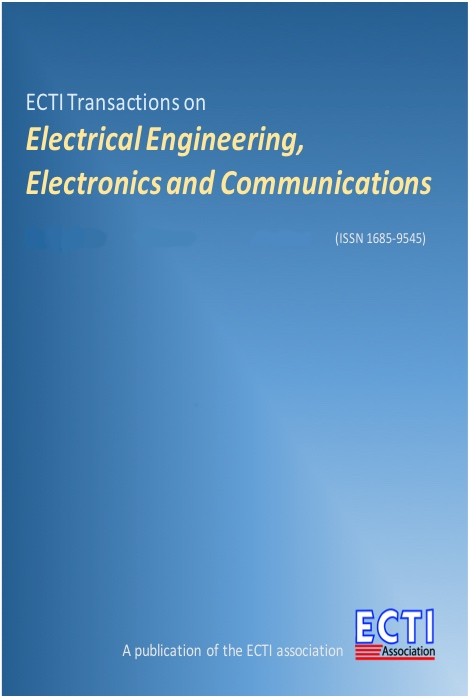High Efficiency Buck-Boost Converter with Three Modes Selection for HV Applications using 0.18 μm Technology
Main Article Content
Abstract
In this paper, we aim to make a detailed study on the evaluation and the characteristics of the non-inverting buck–boost converter. In order to improve the behaviour of the buck-boost converter for the three operating modes, we propose an architecture based on peak current-control. Using a three modes selection circuit and a soft start circuit, this converter is able to expand the power conversion efficiency and reduce inrush current at the feedback loop. The proposed converter is designed to operate with a variable output voltage. In addition, we use LDMOS transistors with low on-resistance, which are adequate for HV applications. The obtained results show that the proposed buck-boost converter perform perfectly compared to others architecture and it is successfully implemented using 0.18 μm CMOS TSMC technology, with an output voltage regulated to 12V and input voltage range of 4-20 V. The power conversion efficiency for the three operating modes buck, boost and buck-boost are 97.6%, 96.3% and 95.5% respectively at load current of 4A.
Article Details
This journal provides immediate open access to its content on the principle that making research freely available to the public supports a greater global exchange of knowledge.
- Creative Commons Copyright License
The journal allows readers to download and share all published articles as long as they properly cite such articles; however, they cannot change them or use them commercially. This is classified as CC BY-NC-ND for the creative commons license.
- Retention of Copyright and Publishing Rights
The journal allows the authors of the published articles to hold copyrights and publishing rights without restrictions.
References
[2] Youssef Ziadi and Hassan Qjidaa. A High Efficiency Li-Ion Battery LDO-Based Charger for Portable Application. Hindawi Publishing Corporation Active and Passive Electronic Components Volume 2015, Article ID 591986, 9 pages.
[3] P. H. V. Quang, T. T. Ha, and J.-W. Lee, Afully integrated multimode wireless power charger IC with adaptive supply control and built-in resistance compensation. IEEE Transactions on Industrial Electronics, vol. 62, no. 2, pp. 1251–1261, 2015.
[4] Rosario Pagano, Michael Baker, and Russell E. Radke. A 0.18- m Monolithic Li-Ion Battery Charger for Wireless Devices Based on Partial Current Sensing and Adaptive Reference Voltage. IEEE JOURNAL OF SOLID-STATE CIRCUITS, vol. 47, no. 6, June 2012.
[5] H.-Y. Yang, T.-H.Wu, J.-J. Chen, Y.-S.Hwang, and C.-C. Yu. An omnipotent Li-Ion battery charger with multimode controlled techniques. in Proceedings of the IEEE 10th International Conference on Power Electronics and Drive Systems (PEDS ’13), pp. 531–534, April 2013.
[6] Karim El Khadiri, and Hassan Qjidaa. Li-Ion Battery Charging with a Buck-Boost DC–DC Converter for a Portable Device Power Management. Journal of Low Power Electronics Vol. 13, 1–8, 2017.
[7] Wu, K.C.; Wu, H.H.; Wei, C.L. Analysis and Design of Mixed-Mode Operation for Noninverting Buck–Boost DC–DC Converters. IEEE Trans. Circuits Syst. II. 62, 1194–1198. 2015.
[8] Fouad Farah, Mustapha EL Alaoui, Karim Elkhadiri, Hassan Qjidaa. New Analog Li-Ion Battery Charger Using Pulsed Charging Method. IEEE Trans. In Proceedings of 6th International Conference on Multimedia Computing and Systems (ICMCS) 2018.
[9] Malcovati, P.; Belloni, M.; Gozzini, F.; Bazzani, C.; Baschirotto, A. A 0.18-um CMOS, 91%-Efficiency, 2-A Scalable Buck-Boost DC–DC Converter for LED Drivers. IEEE Trans. Power Electron. 29, 5392–5398. 2014.
[10] Jiann-jong C, Jui-hsuan H. A DC–DC buck converter with load-regulation improvement using dual-path-feedback techniques. Analog Integr Circ Sig Process 79 149-159. 2014.
[11] Truong Thi Kim Nga, Seong-Mun Park, Young-Jun Park, Sang-Hyuk Park, SangYun Kim, Truong Van Cong Thuong, Minjae Lee, Keum Cheol Hwang, Youngoo Yang and Kang-Yoon Lee. A Wide Input Range Buck-Boost DC–DC Converter Using Hysteresis Triple-Mode Control Technique with Peak Efficiency of 94.8% for RF Energy Harvesting Applications. Energies. 11(7), 1618. 2018.
[12] Jing Xue and Hoi Lee. A 2MHz 60W Zero-Voltage Switching Synchronous Non-Inverting Buck-Boost Converter with Reduced Component Values. IEEE Transactions on Circuits and Systems II: Express Briefs Vol 62 no 7, July 2015.
[13] Shang-Hsien Yang, Jen-Wei Liu, and Chua-Chin Wang. A Single-Chip 60-V Bulk Charger for Series Li-Ion Batteries with Smooth Charge-Mode Transition. IEEE transactions on circuits and systems—i: regular papers, vol. 59, no. 7, July 2012.
[14] Chen, J.-J., Shen, P.-N., & Hwang, Y.-S. A high-efficiency positive buck–boost converter with mode-select circuit and feed-forward techniques. IEEE Transactions on Power Electronics, 28(9), 4240–4247. 2013.
[15] Sahu, B., & Rincon-Mora, G. A. A high-efficiency, dual mode, dynamic, buck–boost power supply IC for portable applications. In International conference on VLSI design (pp. 858–861). 2005.
[16] Yi-yang Tsai, Yu-Shin Tsai, Chien-Wu Tsai, Chien-Hung. Digital Noninverting Buck-Boost Converter with Enhanced Duty Cycle-Overlap Control. IEEE Transactions on Circuits and Systems II, 2016.
[17] Huynh, H.A.; Han, Y.B.; Park, S.H.; Hwang, J.S.; Song, E.S.; Kim, S. Design and Analysis of the DC–DC Converter with a Frequency Hopping Technique for EMI Reduction. IEEE Trans. Compon. Packag. Manuf. Technol. 8, 546–553. 2018.
[18] Choi, B. Pulse width modulated DC-to-DC power conversion: circuits, dynamics, and control designs. New York: Wiley. 2013.
[19] Basso, C. Switch-mode power supplies spice simulations and practical designs. New York: McGraw Hill Professional. 2008.


